Operations and Project Management: Review and Critique of Operations Management Principles in Tesco PLC
VerifiedAdded on 2023/06/04
|14
|4940
|189
AI Summary
This report provides a review and critique of the implementation of operations management principles within Tesco PLC, including an analysis of the extent to which the operations management of the organisation meets the requirements of the organization. It also discusses continuous improvement as a philosophy and describes the Lean principles.
Contribute Materials
Your contribution can guide someone’s learning journey. Share your
documents today.

ID
Unit Number and Title Unit 187 –
Operations and
Project Management
Title Review and Critique
of Operations
Management (Part
1
Unit Number and Title Unit 187 –
Operations and
Project Management
Title Review and Critique
of Operations
Management (Part
1
Secure Best Marks with AI Grader
Need help grading? Try our AI Grader for instant feedback on your assignments.
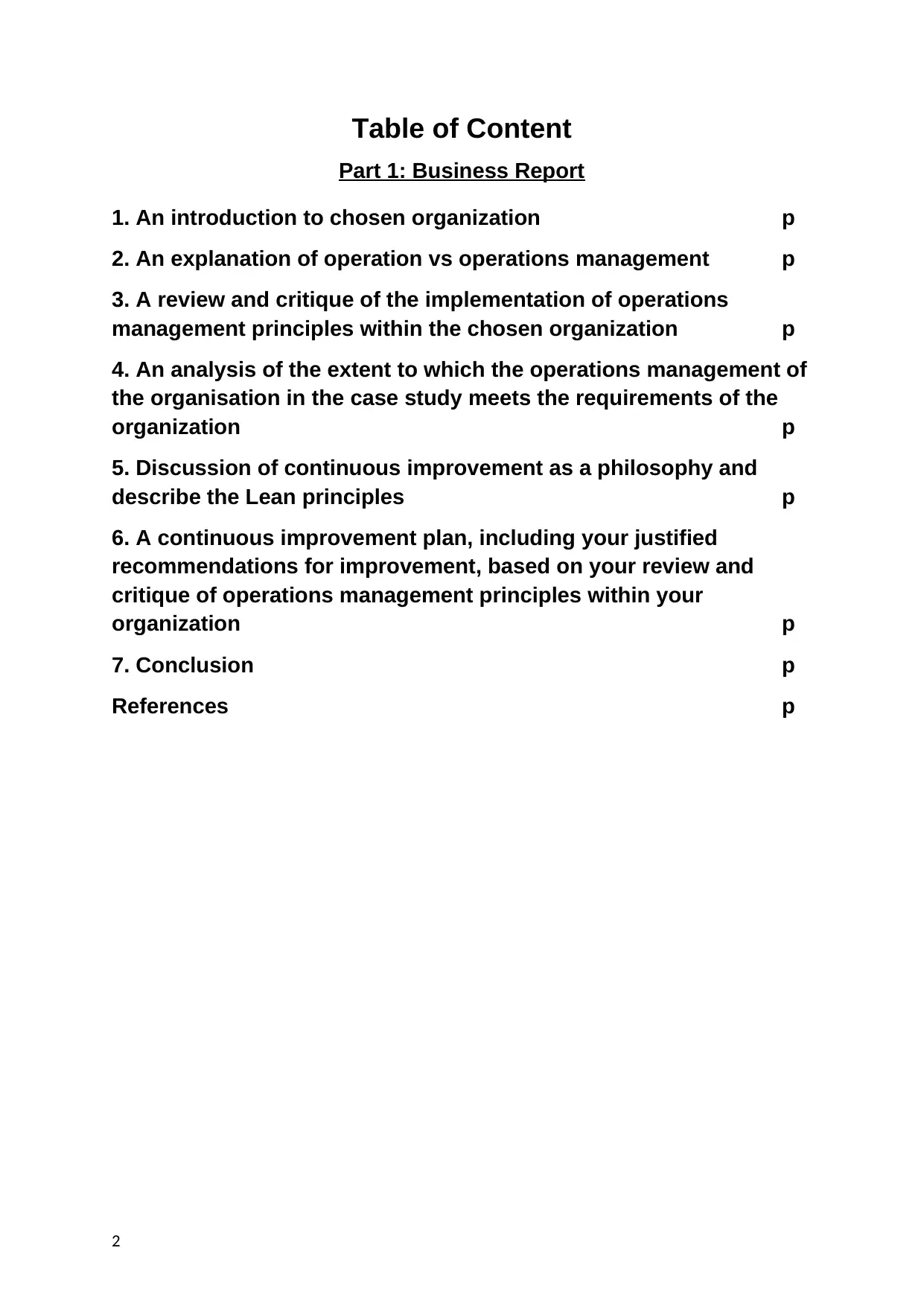
Table of Content
Part 1: Business Report
1. An introduction to chosen organization p
2. An explanation of operation vs operations management p
3. A review and critique of the implementation of operations
management principles within the chosen organization p
4. An analysis of the extent to which the operations management of
the organisation in the case study meets the requirements of the
organization p
5. Discussion of continuous improvement as a philosophy and
describe the Lean principles p
6. A continuous improvement plan, including your justified
recommendations for improvement, based on your review and
critique of operations management principles within your
organization p
7. Conclusion p
References p
2
Part 1: Business Report
1. An introduction to chosen organization p
2. An explanation of operation vs operations management p
3. A review and critique of the implementation of operations
management principles within the chosen organization p
4. An analysis of the extent to which the operations management of
the organisation in the case study meets the requirements of the
organization p
5. Discussion of continuous improvement as a philosophy and
describe the Lean principles p
6. A continuous improvement plan, including your justified
recommendations for improvement, based on your review and
critique of operations management principles within your
organization p
7. Conclusion p
References p
2
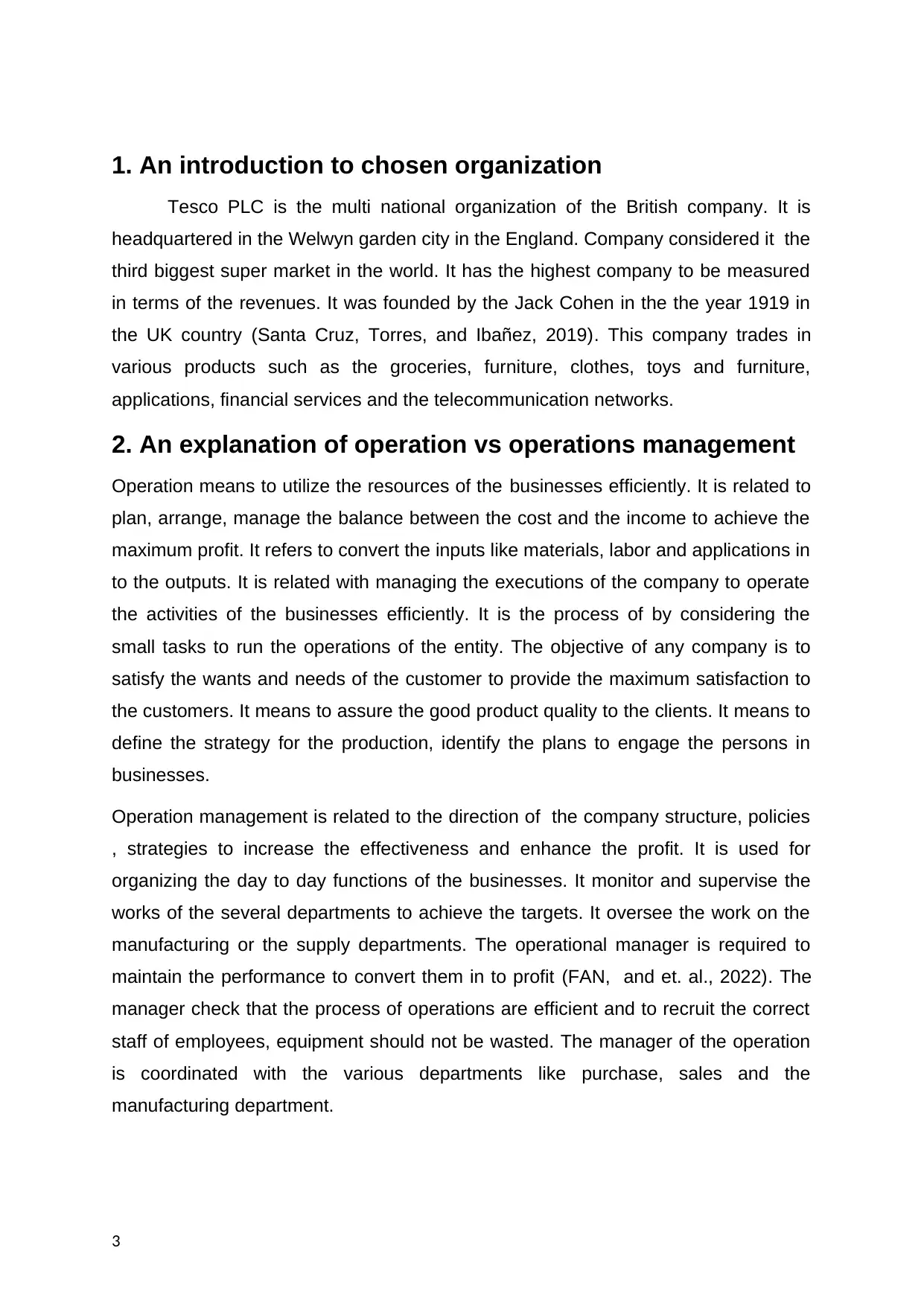
1. An introduction to chosen organization
Tesco PLC is the multi national organization of the British company. It is
headquartered in the Welwyn garden city in the England. Company considered it the
third biggest super market in the world. It has the highest company to be measured
in terms of the revenues. It was founded by the Jack Cohen in the the year 1919 in
the UK country (Santa Cruz, Torres, and Ibañez, 2019). This company trades in
various products such as the groceries, furniture, clothes, toys and furniture,
applications, financial services and the telecommunication networks.
2. An explanation of operation vs operations management
Operation means to utilize the resources of the businesses efficiently. It is related to
plan, arrange, manage the balance between the cost and the income to achieve the
maximum profit. It refers to convert the inputs like materials, labor and applications in
to the outputs. It is related with managing the executions of the company to operate
the activities of the businesses efficiently. It is the process of by considering the
small tasks to run the operations of the entity. The objective of any company is to
satisfy the wants and needs of the customer to provide the maximum satisfaction to
the customers. It means to assure the good product quality to the clients. It means to
define the strategy for the production, identify the plans to engage the persons in
businesses.
Operation management is related to the direction of the company structure, policies
, strategies to increase the effectiveness and enhance the profit. It is used for
organizing the day to day functions of the businesses. It monitor and supervise the
works of the several departments to achieve the targets. It oversee the work on the
manufacturing or the supply departments. The operational manager is required to
maintain the performance to convert them in to profit (FAN, and et. al., 2022). The
manager check that the process of operations are efficient and to recruit the correct
staff of employees, equipment should not be wasted. The manager of the operation
is coordinated with the various departments like purchase, sales and the
manufacturing department.
3
Tesco PLC is the multi national organization of the British company. It is
headquartered in the Welwyn garden city in the England. Company considered it the
third biggest super market in the world. It has the highest company to be measured
in terms of the revenues. It was founded by the Jack Cohen in the the year 1919 in
the UK country (Santa Cruz, Torres, and Ibañez, 2019). This company trades in
various products such as the groceries, furniture, clothes, toys and furniture,
applications, financial services and the telecommunication networks.
2. An explanation of operation vs operations management
Operation means to utilize the resources of the businesses efficiently. It is related to
plan, arrange, manage the balance between the cost and the income to achieve the
maximum profit. It refers to convert the inputs like materials, labor and applications in
to the outputs. It is related with managing the executions of the company to operate
the activities of the businesses efficiently. It is the process of by considering the
small tasks to run the operations of the entity. The objective of any company is to
satisfy the wants and needs of the customer to provide the maximum satisfaction to
the customers. It means to assure the good product quality to the clients. It means to
define the strategy for the production, identify the plans to engage the persons in
businesses.
Operation management is related to the direction of the company structure, policies
, strategies to increase the effectiveness and enhance the profit. It is used for
organizing the day to day functions of the businesses. It monitor and supervise the
works of the several departments to achieve the targets. It oversee the work on the
manufacturing or the supply departments. The operational manager is required to
maintain the performance to convert them in to profit (FAN, and et. al., 2022). The
manager check that the process of operations are efficient and to recruit the correct
staff of employees, equipment should not be wasted. The manager of the operation
is coordinated with the various departments like purchase, sales and the
manufacturing department.
3
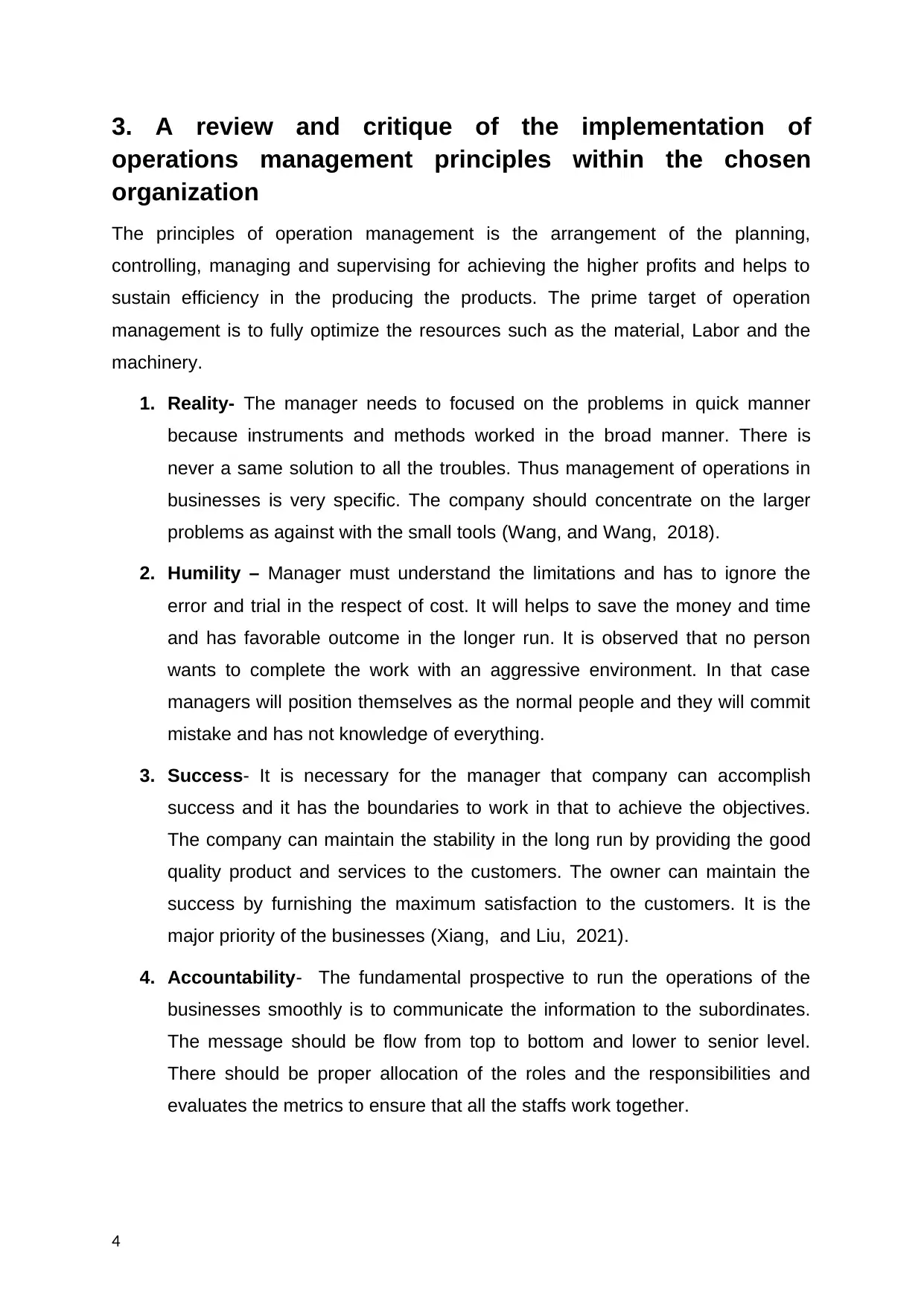
3. A review and critique of the implementation of
operations management principles within the chosen
organization
The principles of operation management is the arrangement of the planning,
controlling, managing and supervising for achieving the higher profits and helps to
sustain efficiency in the producing the products. The prime target of operation
management is to fully optimize the resources such as the material, Labor and the
machinery.
1. Reality- The manager needs to focused on the problems in quick manner
because instruments and methods worked in the broad manner. There is
never a same solution to all the troubles. Thus management of operations in
businesses is very specific. The company should concentrate on the larger
problems as against with the small tools (Wang, and Wang, 2018).
2. Humility – Manager must understand the limitations and has to ignore the
error and trial in the respect of cost. It will helps to save the money and time
and has favorable outcome in the longer run. It is observed that no person
wants to complete the work with an aggressive environment. In that case
managers will position themselves as the normal people and they will commit
mistake and has not knowledge of everything.
3. Success- It is necessary for the manager that company can accomplish
success and it has the boundaries to work in that to achieve the objectives.
The company can maintain the stability in the long run by providing the good
quality product and services to the customers. The owner can maintain the
success by furnishing the maximum satisfaction to the customers. It is the
major priority of the businesses (Xiang, and Liu, 2021).
4. Accountability- The fundamental prospective to run the operations of the
businesses smoothly is to communicate the information to the subordinates.
The message should be flow from top to bottom and lower to senior level.
There should be proper allocation of the roles and the responsibilities and
evaluates the metrics to ensure that all the staffs work together.
4
operations management principles within the chosen
organization
The principles of operation management is the arrangement of the planning,
controlling, managing and supervising for achieving the higher profits and helps to
sustain efficiency in the producing the products. The prime target of operation
management is to fully optimize the resources such as the material, Labor and the
machinery.
1. Reality- The manager needs to focused on the problems in quick manner
because instruments and methods worked in the broad manner. There is
never a same solution to all the troubles. Thus management of operations in
businesses is very specific. The company should concentrate on the larger
problems as against with the small tools (Wang, and Wang, 2018).
2. Humility – Manager must understand the limitations and has to ignore the
error and trial in the respect of cost. It will helps to save the money and time
and has favorable outcome in the longer run. It is observed that no person
wants to complete the work with an aggressive environment. In that case
managers will position themselves as the normal people and they will commit
mistake and has not knowledge of everything.
3. Success- It is necessary for the manager that company can accomplish
success and it has the boundaries to work in that to achieve the objectives.
The company can maintain the stability in the long run by providing the good
quality product and services to the customers. The owner can maintain the
success by furnishing the maximum satisfaction to the customers. It is the
major priority of the businesses (Xiang, and Liu, 2021).
4. Accountability- The fundamental prospective to run the operations of the
businesses smoothly is to communicate the information to the subordinates.
The message should be flow from top to bottom and lower to senior level.
There should be proper allocation of the roles and the responsibilities and
evaluates the metrics to ensure that all the staffs work together.
4
Secure Best Marks with AI Grader
Need help grading? Try our AI Grader for instant feedback on your assignments.
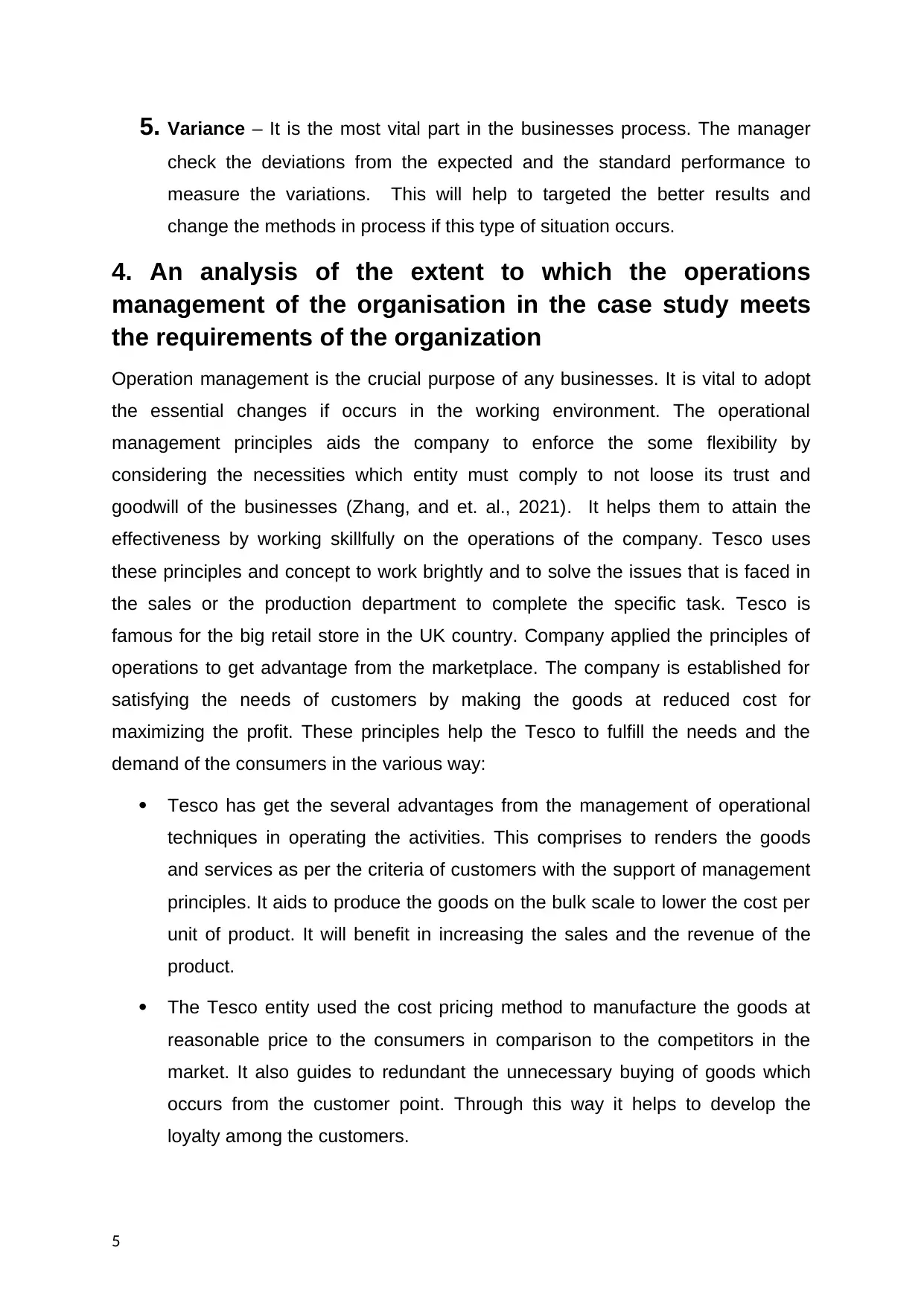
5. Variance – It is the most vital part in the businesses process. The manager
check the deviations from the expected and the standard performance to
measure the variations. This will help to targeted the better results and
change the methods in process if this type of situation occurs.
4. An analysis of the extent to which the operations
management of the organisation in the case study meets
the requirements of the organization
Operation management is the crucial purpose of any businesses. It is vital to adopt
the essential changes if occurs in the working environment. The operational
management principles aids the company to enforce the some flexibility by
considering the necessities which entity must comply to not loose its trust and
goodwill of the businesses (Zhang, and et. al., 2021). It helps them to attain the
effectiveness by working skillfully on the operations of the company. Tesco uses
these principles and concept to work brightly and to solve the issues that is faced in
the sales or the production department to complete the specific task. Tesco is
famous for the big retail store in the UK country. Company applied the principles of
operations to get advantage from the marketplace. The company is established for
satisfying the needs of customers by making the goods at reduced cost for
maximizing the profit. These principles help the Tesco to fulfill the needs and the
demand of the consumers in the various way:
Tesco has get the several advantages from the management of operational
techniques in operating the activities. This comprises to renders the goods
and services as per the criteria of customers with the support of management
principles. It aids to produce the goods on the bulk scale to lower the cost per
unit of product. It will benefit in increasing the sales and the revenue of the
product.
The Tesco entity used the cost pricing method to manufacture the goods at
reasonable price to the consumers in comparison to the competitors in the
market. It also guides to redundant the unnecessary buying of goods which
occurs from the customer point. Through this way it helps to develop the
loyalty among the customers.
5
check the deviations from the expected and the standard performance to
measure the variations. This will help to targeted the better results and
change the methods in process if this type of situation occurs.
4. An analysis of the extent to which the operations
management of the organisation in the case study meets
the requirements of the organization
Operation management is the crucial purpose of any businesses. It is vital to adopt
the essential changes if occurs in the working environment. The operational
management principles aids the company to enforce the some flexibility by
considering the necessities which entity must comply to not loose its trust and
goodwill of the businesses (Zhang, and et. al., 2021). It helps them to attain the
effectiveness by working skillfully on the operations of the company. Tesco uses
these principles and concept to work brightly and to solve the issues that is faced in
the sales or the production department to complete the specific task. Tesco is
famous for the big retail store in the UK country. Company applied the principles of
operations to get advantage from the marketplace. The company is established for
satisfying the needs of customers by making the goods at reduced cost for
maximizing the profit. These principles help the Tesco to fulfill the needs and the
demand of the consumers in the various way:
Tesco has get the several advantages from the management of operational
techniques in operating the activities. This comprises to renders the goods
and services as per the criteria of customers with the support of management
principles. It aids to produce the goods on the bulk scale to lower the cost per
unit of product. It will benefit in increasing the sales and the revenue of the
product.
The Tesco entity used the cost pricing method to manufacture the goods at
reasonable price to the consumers in comparison to the competitors in the
market. It also guides to redundant the unnecessary buying of goods which
occurs from the customer point. Through this way it helps to develop the
loyalty among the customers.
5
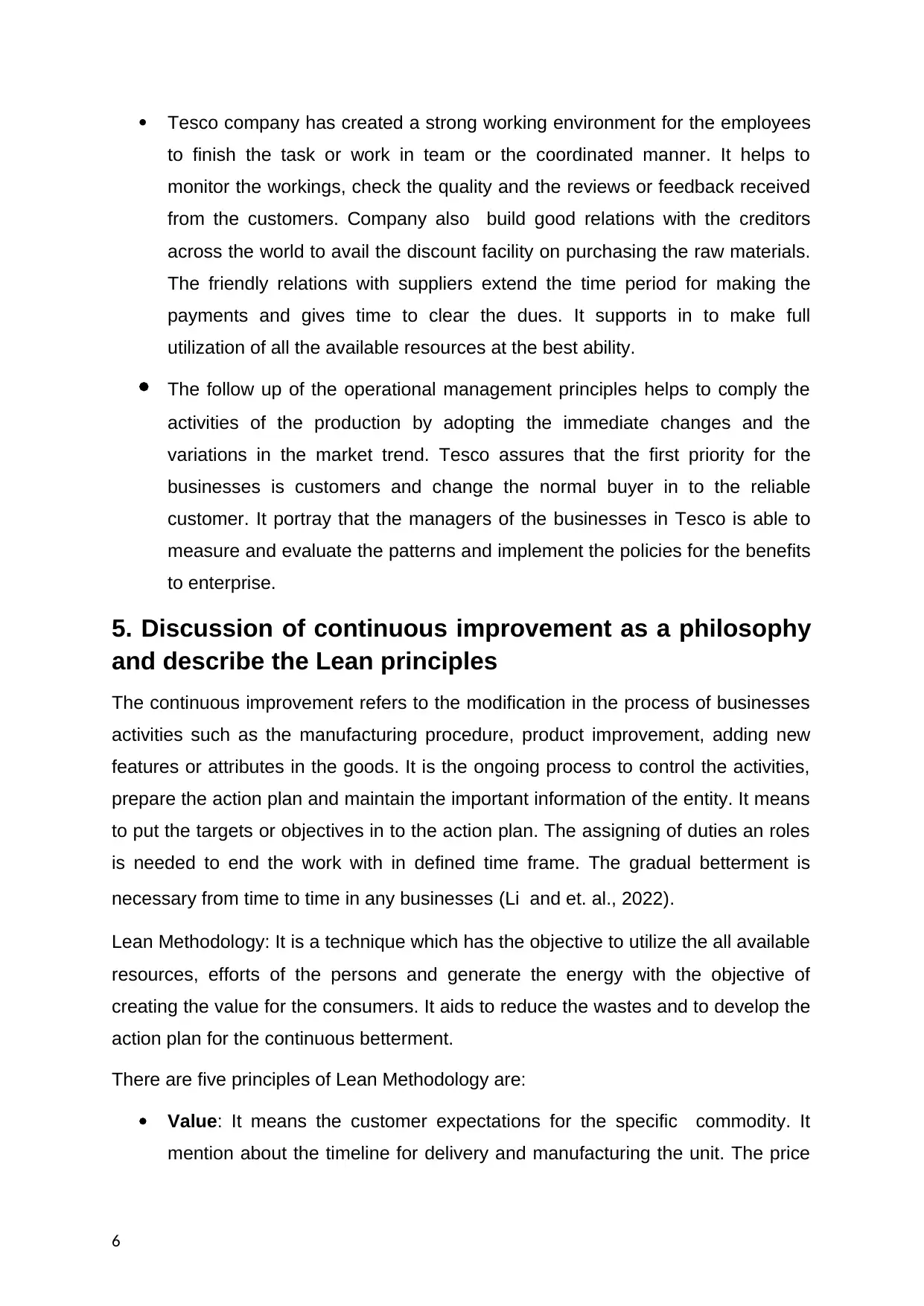
Tesco company has created a strong working environment for the employees
to finish the task or work in team or the coordinated manner. It helps to
monitor the workings, check the quality and the reviews or feedback received
from the customers. Company also build good relations with the creditors
across the world to avail the discount facility on purchasing the raw materials.
The friendly relations with suppliers extend the time period for making the
payments and gives time to clear the dues. It supports in to make full
utilization of all the available resources at the best ability.
The follow up of the operational management principles helps to comply the
activities of the production by adopting the immediate changes and the
variations in the market trend. Tesco assures that the first priority for the
businesses is customers and change the normal buyer in to the reliable
customer. It portray that the managers of the businesses in Tesco is able to
measure and evaluate the patterns and implement the policies for the benefits
to enterprise.
5. Discussion of continuous improvement as a philosophy
and describe the Lean principles
The continuous improvement refers to the modification in the process of businesses
activities such as the manufacturing procedure, product improvement, adding new
features or attributes in the goods. It is the ongoing process to control the activities,
prepare the action plan and maintain the important information of the entity. It means
to put the targets or objectives in to the action plan. The assigning of duties an roles
is needed to end the work with in defined time frame. The gradual betterment is
necessary from time to time in any businesses (Li and et. al., 2022).
Lean Methodology: It is a technique which has the objective to utilize the all available
resources, efforts of the persons and generate the energy with the objective of
creating the value for the consumers. It aids to reduce the wastes and to develop the
action plan for the continuous betterment.
There are five principles of Lean Methodology are:
Value: It means the customer expectations for the specific commodity. It
mention about the timeline for delivery and manufacturing the unit. The price
6
to finish the task or work in team or the coordinated manner. It helps to
monitor the workings, check the quality and the reviews or feedback received
from the customers. Company also build good relations with the creditors
across the world to avail the discount facility on purchasing the raw materials.
The friendly relations with suppliers extend the time period for making the
payments and gives time to clear the dues. It supports in to make full
utilization of all the available resources at the best ability.
The follow up of the operational management principles helps to comply the
activities of the production by adopting the immediate changes and the
variations in the market trend. Tesco assures that the first priority for the
businesses is customers and change the normal buyer in to the reliable
customer. It portray that the managers of the businesses in Tesco is able to
measure and evaluate the patterns and implement the policies for the benefits
to enterprise.
5. Discussion of continuous improvement as a philosophy
and describe the Lean principles
The continuous improvement refers to the modification in the process of businesses
activities such as the manufacturing procedure, product improvement, adding new
features or attributes in the goods. It is the ongoing process to control the activities,
prepare the action plan and maintain the important information of the entity. It means
to put the targets or objectives in to the action plan. The assigning of duties an roles
is needed to end the work with in defined time frame. The gradual betterment is
necessary from time to time in any businesses (Li and et. al., 2022).
Lean Methodology: It is a technique which has the objective to utilize the all available
resources, efforts of the persons and generate the energy with the objective of
creating the value for the consumers. It aids to reduce the wastes and to develop the
action plan for the continuous betterment.
There are five principles of Lean Methodology are:
Value: It means the customer expectations for the specific commodity. It
mention about the timeline for delivery and manufacturing the unit. The price
6
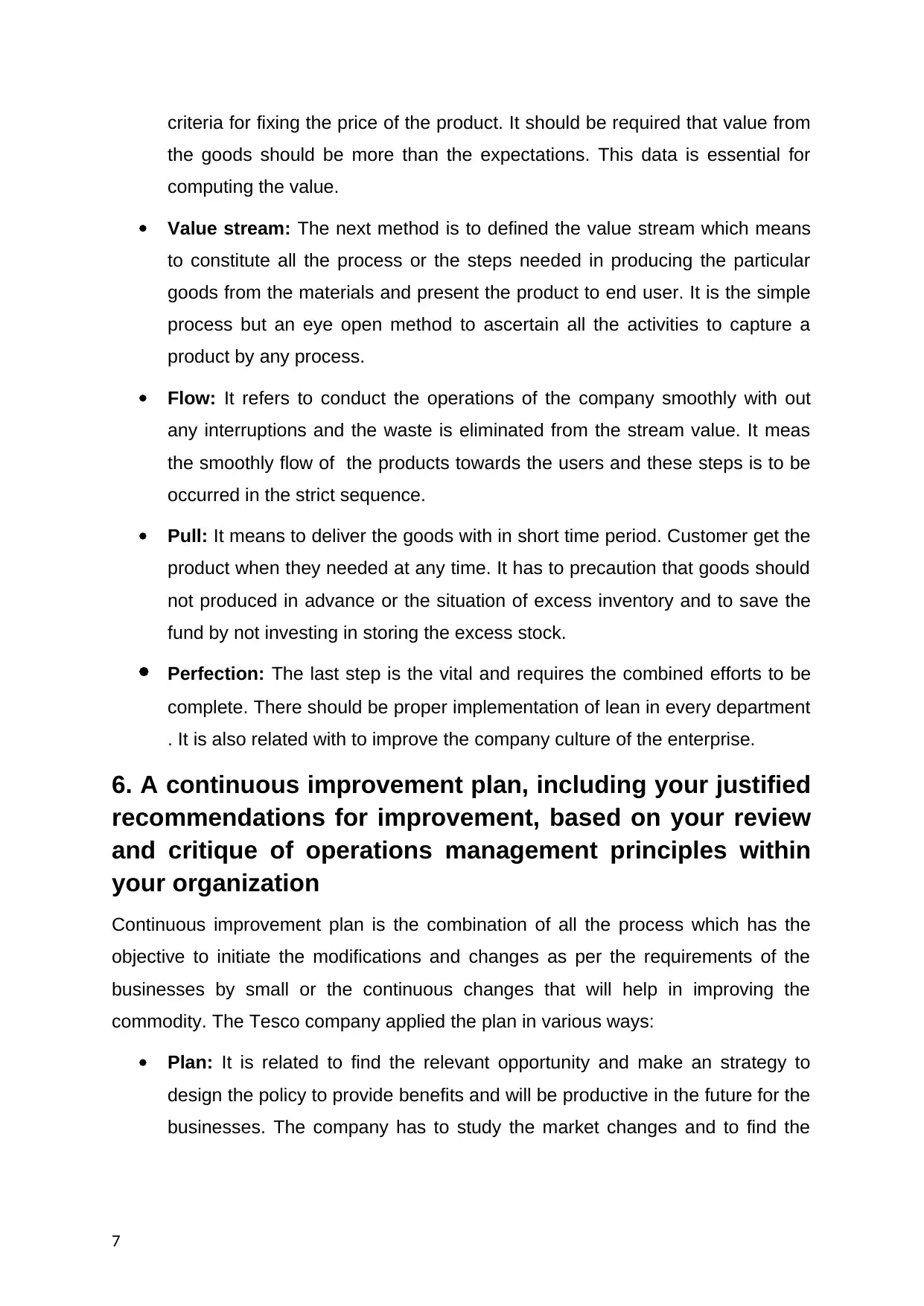
criteria for fixing the price of the product. It should be required that value from
the goods should be more than the expectations. This data is essential for
computing the value.
Value stream: The next method is to defined the value stream which means
to constitute all the process or the steps needed in producing the particular
goods from the materials and present the product to end user. It is the simple
process but an eye open method to ascertain all the activities to capture a
product by any process.
Flow: It refers to conduct the operations of the company smoothly with out
any interruptions and the waste is eliminated from the stream value. It meas
the smoothly flow of the products towards the users and these steps is to be
occurred in the strict sequence.
Pull: It means to deliver the goods with in short time period. Customer get the
product when they needed at any time. It has to precaution that goods should
not produced in advance or the situation of excess inventory and to save the
fund by not investing in storing the excess stock.
Perfection: The last step is the vital and requires the combined efforts to be
complete. There should be proper implementation of lean in every department
. It is also related with to improve the company culture of the enterprise.
6. A continuous improvement plan, including your justified
recommendations for improvement, based on your review
and critique of operations management principles within
your organization
Continuous improvement plan is the combination of all the process which has the
objective to initiate the modifications and changes as per the requirements of the
businesses by small or the continuous changes that will help in improving the
commodity. The Tesco company applied the plan in various ways:
Plan: It is related to find the relevant opportunity and make an strategy to
design the policy to provide benefits and will be productive in the future for the
businesses. The company has to study the market changes and to find the
7
the goods should be more than the expectations. This data is essential for
computing the value.
Value stream: The next method is to defined the value stream which means
to constitute all the process or the steps needed in producing the particular
goods from the materials and present the product to end user. It is the simple
process but an eye open method to ascertain all the activities to capture a
product by any process.
Flow: It refers to conduct the operations of the company smoothly with out
any interruptions and the waste is eliminated from the stream value. It meas
the smoothly flow of the products towards the users and these steps is to be
occurred in the strict sequence.
Pull: It means to deliver the goods with in short time period. Customer get the
product when they needed at any time. It has to precaution that goods should
not produced in advance or the situation of excess inventory and to save the
fund by not investing in storing the excess stock.
Perfection: The last step is the vital and requires the combined efforts to be
complete. There should be proper implementation of lean in every department
. It is also related with to improve the company culture of the enterprise.
6. A continuous improvement plan, including your justified
recommendations for improvement, based on your review
and critique of operations management principles within
your organization
Continuous improvement plan is the combination of all the process which has the
objective to initiate the modifications and changes as per the requirements of the
businesses by small or the continuous changes that will help in improving the
commodity. The Tesco company applied the plan in various ways:
Plan: It is related to find the relevant opportunity and make an strategy to
design the policy to provide benefits and will be productive in the future for the
businesses. The company has to study the market changes and to find the
7
Paraphrase This Document
Need a fresh take? Get an instant paraphrase of this document with our AI Paraphraser
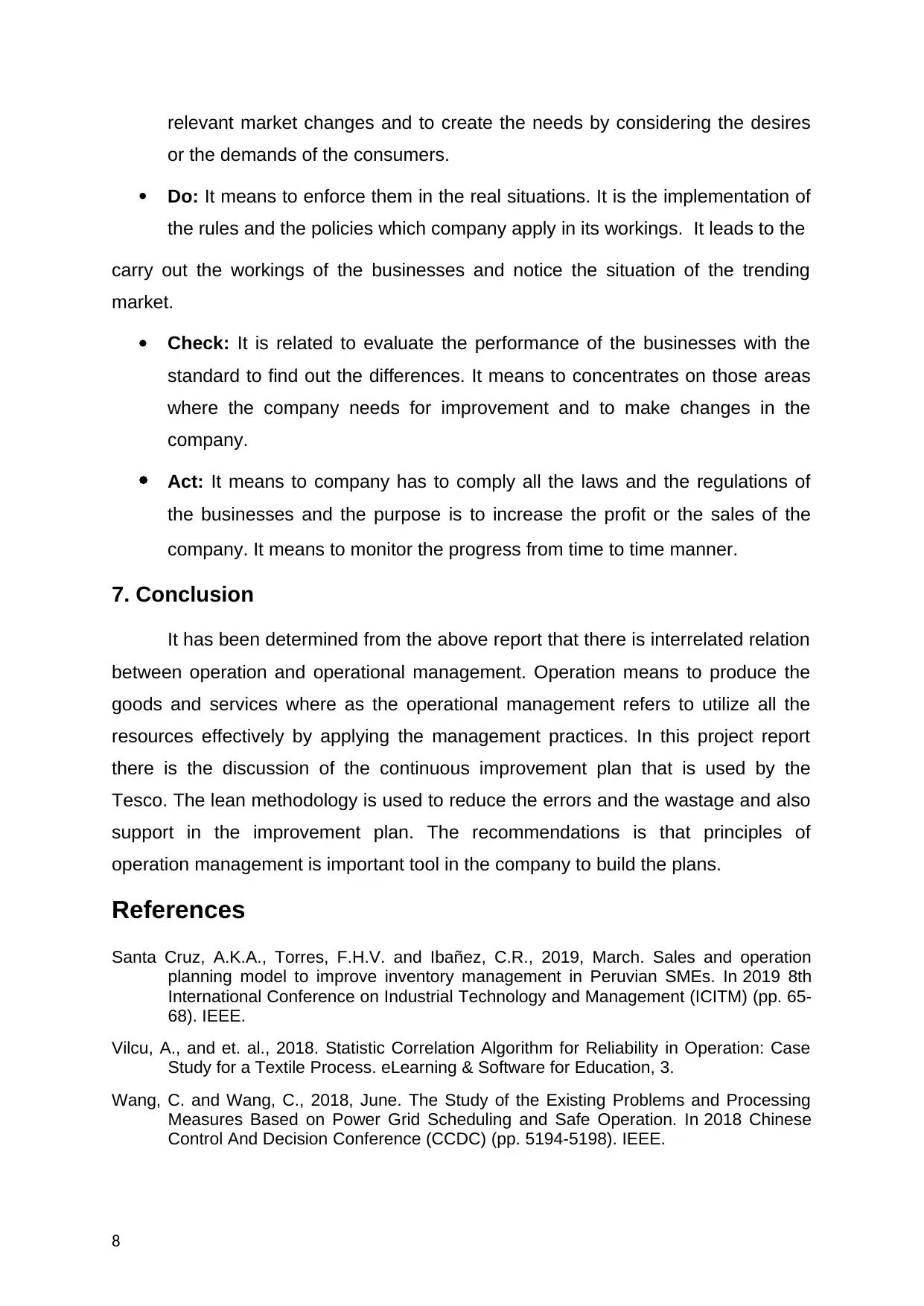
relevant market changes and to create the needs by considering the desires
or the demands of the consumers.
Do: It means to enforce them in the real situations. It is the implementation of
the rules and the policies which company apply in its workings. It leads to the
carry out the workings of the businesses and notice the situation of the trending
market.
Check: It is related to evaluate the performance of the businesses with the
standard to find out the differences. It means to concentrates on those areas
where the company needs for improvement and to make changes in the
company.
Act: It means to company has to comply all the laws and the regulations of
the businesses and the purpose is to increase the profit or the sales of the
company. It means to monitor the progress from time to time manner.
7. Conclusion
It has been determined from the above report that there is interrelated relation
between operation and operational management. Operation means to produce the
goods and services where as the operational management refers to utilize all the
resources effectively by applying the management practices. In this project report
there is the discussion of the continuous improvement plan that is used by the
Tesco. The lean methodology is used to reduce the errors and the wastage and also
support in the improvement plan. The recommendations is that principles of
operation management is important tool in the company to build the plans.
References
Santa Cruz, A.K.A., Torres, F.H.V. and Ibañez, C.R., 2019, March. Sales and operation
planning model to improve inventory management in Peruvian SMEs. In 2019 8th
International Conference on Industrial Technology and Management (ICITM) (pp. 65-
68). IEEE.
Vilcu, A., and et. al., 2018. Statistic Correlation Algorithm for Reliability in Operation: Case
Study for a Textile Process. eLearning & Software for Education, 3.
Wang, C. and Wang, C., 2018, June. The Study of the Existing Problems and Processing
Measures Based on Power Grid Scheduling and Safe Operation. In 2018 Chinese
Control And Decision Conference (CCDC) (pp. 5194-5198). IEEE.
8
or the demands of the consumers.
Do: It means to enforce them in the real situations. It is the implementation of
the rules and the policies which company apply in its workings. It leads to the
carry out the workings of the businesses and notice the situation of the trending
market.
Check: It is related to evaluate the performance of the businesses with the
standard to find out the differences. It means to concentrates on those areas
where the company needs for improvement and to make changes in the
company.
Act: It means to company has to comply all the laws and the regulations of
the businesses and the purpose is to increase the profit or the sales of the
company. It means to monitor the progress from time to time manner.
7. Conclusion
It has been determined from the above report that there is interrelated relation
between operation and operational management. Operation means to produce the
goods and services where as the operational management refers to utilize all the
resources effectively by applying the management practices. In this project report
there is the discussion of the continuous improvement plan that is used by the
Tesco. The lean methodology is used to reduce the errors and the wastage and also
support in the improvement plan. The recommendations is that principles of
operation management is important tool in the company to build the plans.
References
Santa Cruz, A.K.A., Torres, F.H.V. and Ibañez, C.R., 2019, March. Sales and operation
planning model to improve inventory management in Peruvian SMEs. In 2019 8th
International Conference on Industrial Technology and Management (ICITM) (pp. 65-
68). IEEE.
Vilcu, A., and et. al., 2018. Statistic Correlation Algorithm for Reliability in Operation: Case
Study for a Textile Process. eLearning & Software for Education, 3.
Wang, C. and Wang, C., 2018, June. The Study of the Existing Problems and Processing
Measures Based on Power Grid Scheduling and Safe Operation. In 2018 Chinese
Control And Decision Conference (CCDC) (pp. 5194-5198). IEEE.
8
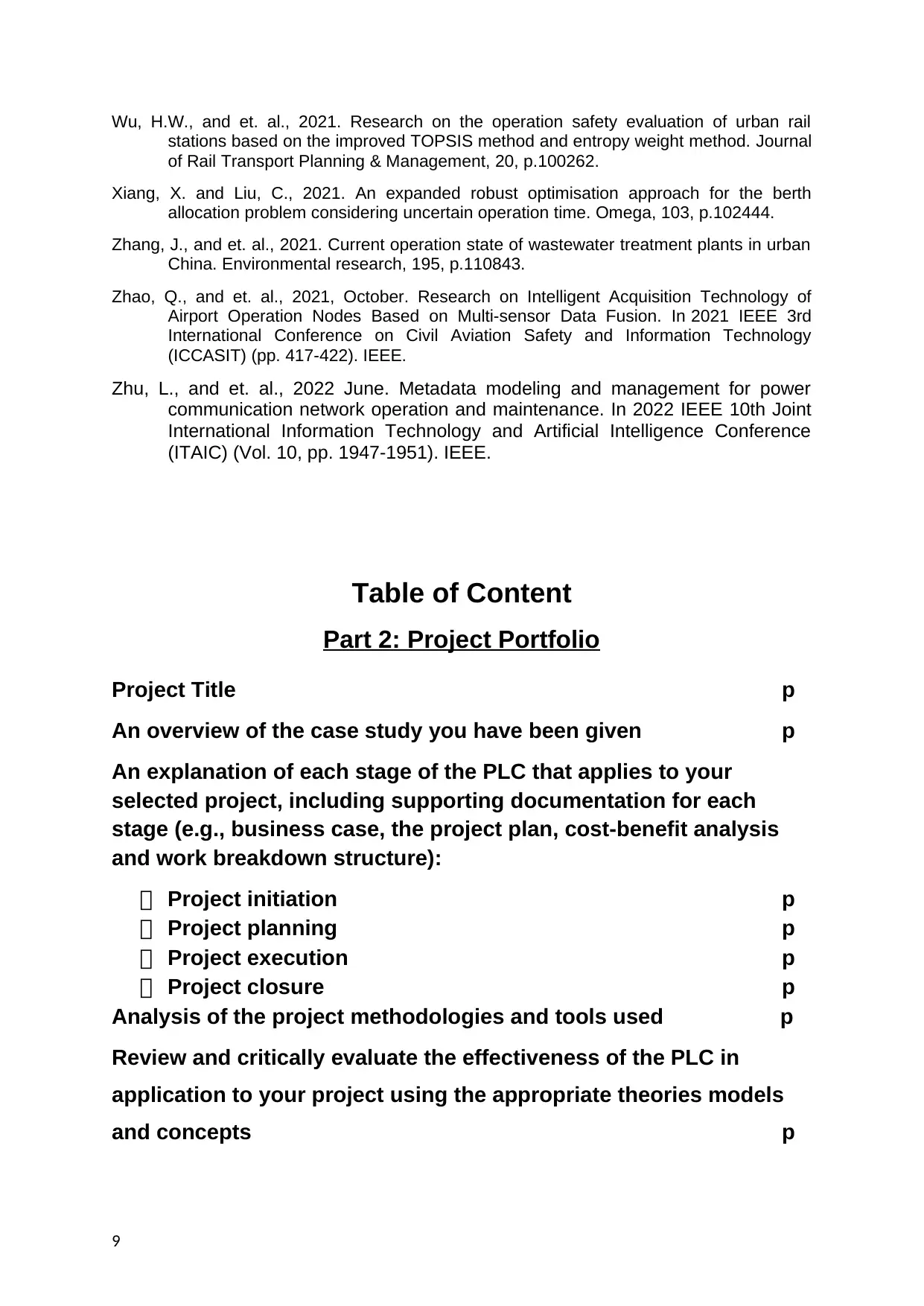
Wu, H.W., and et. al., 2021. Research on the operation safety evaluation of urban rail
stations based on the improved TOPSIS method and entropy weight method. Journal
of Rail Transport Planning & Management, 20, p.100262.
Xiang, X. and Liu, C., 2021. An expanded robust optimisation approach for the berth
allocation problem considering uncertain operation time. Omega, 103, p.102444.
Zhang, J., and et. al., 2021. Current operation state of wastewater treatment plants in urban
China. Environmental research, 195, p.110843.
Zhao, Q., and et. al., 2021, October. Research on Intelligent Acquisition Technology of
Airport Operation Nodes Based on Multi-sensor Data Fusion. In 2021 IEEE 3rd
International Conference on Civil Aviation Safety and Information Technology
(ICCASIT) (pp. 417-422). IEEE.
Zhu, L., and et. al., 2022 June. Metadata modeling and management for power
communication network operation and maintenance. In 2022 IEEE 10th Joint
International Information Technology and Artificial Intelligence Conference
(ITAIC) (Vol. 10, pp. 1947-1951). IEEE.
Table of Content
Part 2: Project Portfolio
Project Title p
An overview of the case study you have been given p
An explanation of each stage of the PLC that applies to your
selected project, including supporting documentation for each
stage (e.g., business case, the project plan, cost-benefit analysis
and work breakdown structure):
Project initiation p
Project planning p
Project execution p
Project closure p
Analysis of the project methodologies and tools used p
Review and critically evaluate the effectiveness of the PLC in
application to your project using the appropriate theories models
and concepts p
9
stations based on the improved TOPSIS method and entropy weight method. Journal
of Rail Transport Planning & Management, 20, p.100262.
Xiang, X. and Liu, C., 2021. An expanded robust optimisation approach for the berth
allocation problem considering uncertain operation time. Omega, 103, p.102444.
Zhang, J., and et. al., 2021. Current operation state of wastewater treatment plants in urban
China. Environmental research, 195, p.110843.
Zhao, Q., and et. al., 2021, October. Research on Intelligent Acquisition Technology of
Airport Operation Nodes Based on Multi-sensor Data Fusion. In 2021 IEEE 3rd
International Conference on Civil Aviation Safety and Information Technology
(ICCASIT) (pp. 417-422). IEEE.
Zhu, L., and et. al., 2022 June. Metadata modeling and management for power
communication network operation and maintenance. In 2022 IEEE 10th Joint
International Information Technology and Artificial Intelligence Conference
(ITAIC) (Vol. 10, pp. 1947-1951). IEEE.
Table of Content
Part 2: Project Portfolio
Project Title p
An overview of the case study you have been given p
An explanation of each stage of the PLC that applies to your
selected project, including supporting documentation for each
stage (e.g., business case, the project plan, cost-benefit analysis
and work breakdown structure):
Project initiation p
Project planning p
Project execution p
Project closure p
Analysis of the project methodologies and tools used p
Review and critically evaluate the effectiveness of the PLC in
application to your project using the appropriate theories models
and concepts p
9
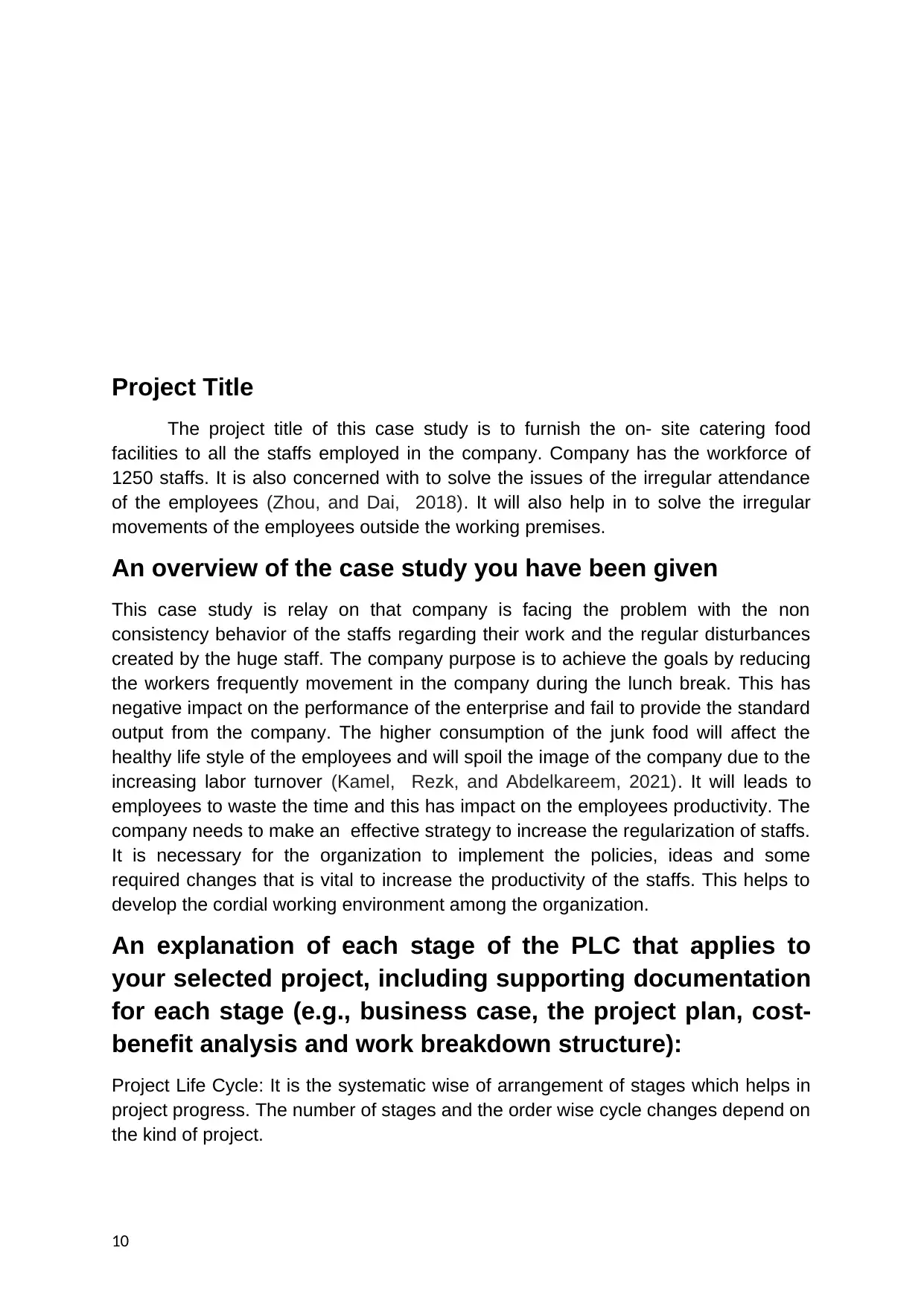
Project Title
The project title of this case study is to furnish the on- site catering food
facilities to all the staffs employed in the company. Company has the workforce of
1250 staffs. It is also concerned with to solve the issues of the irregular attendance
of the employees (Zhou, and Dai, 2018). It will also help in to solve the irregular
movements of the employees outside the working premises.
An overview of the case study you have been given
This case study is relay on that company is facing the problem with the non
consistency behavior of the staffs regarding their work and the regular disturbances
created by the huge staff. The company purpose is to achieve the goals by reducing
the workers frequently movement in the company during the lunch break. This has
negative impact on the performance of the enterprise and fail to provide the standard
output from the company. The higher consumption of the junk food will affect the
healthy life style of the employees and will spoil the image of the company due to the
increasing labor turnover (Kamel, Rezk, and Abdelkareem, 2021). It will leads to
employees to waste the time and this has impact on the employees productivity. The
company needs to make an effective strategy to increase the regularization of staffs.
It is necessary for the organization to implement the policies, ideas and some
required changes that is vital to increase the productivity of the staffs. This helps to
develop the cordial working environment among the organization.
An explanation of each stage of the PLC that applies to
your selected project, including supporting documentation
for each stage (e.g., business case, the project plan, cost-
benefit analysis and work breakdown structure):
Project Life Cycle: It is the systematic wise of arrangement of stages which helps in
project progress. The number of stages and the order wise cycle changes depend on
the kind of project.
10
The project title of this case study is to furnish the on- site catering food
facilities to all the staffs employed in the company. Company has the workforce of
1250 staffs. It is also concerned with to solve the issues of the irregular attendance
of the employees (Zhou, and Dai, 2018). It will also help in to solve the irregular
movements of the employees outside the working premises.
An overview of the case study you have been given
This case study is relay on that company is facing the problem with the non
consistency behavior of the staffs regarding their work and the regular disturbances
created by the huge staff. The company purpose is to achieve the goals by reducing
the workers frequently movement in the company during the lunch break. This has
negative impact on the performance of the enterprise and fail to provide the standard
output from the company. The higher consumption of the junk food will affect the
healthy life style of the employees and will spoil the image of the company due to the
increasing labor turnover (Kamel, Rezk, and Abdelkareem, 2021). It will leads to
employees to waste the time and this has impact on the employees productivity. The
company needs to make an effective strategy to increase the regularization of staffs.
It is necessary for the organization to implement the policies, ideas and some
required changes that is vital to increase the productivity of the staffs. This helps to
develop the cordial working environment among the organization.
An explanation of each stage of the PLC that applies to
your selected project, including supporting documentation
for each stage (e.g., business case, the project plan, cost-
benefit analysis and work breakdown structure):
Project Life Cycle: It is the systematic wise of arrangement of stages which helps in
project progress. The number of stages and the order wise cycle changes depend on
the kind of project.
10
Secure Best Marks with AI Grader
Need help grading? Try our AI Grader for instant feedback on your assignments.
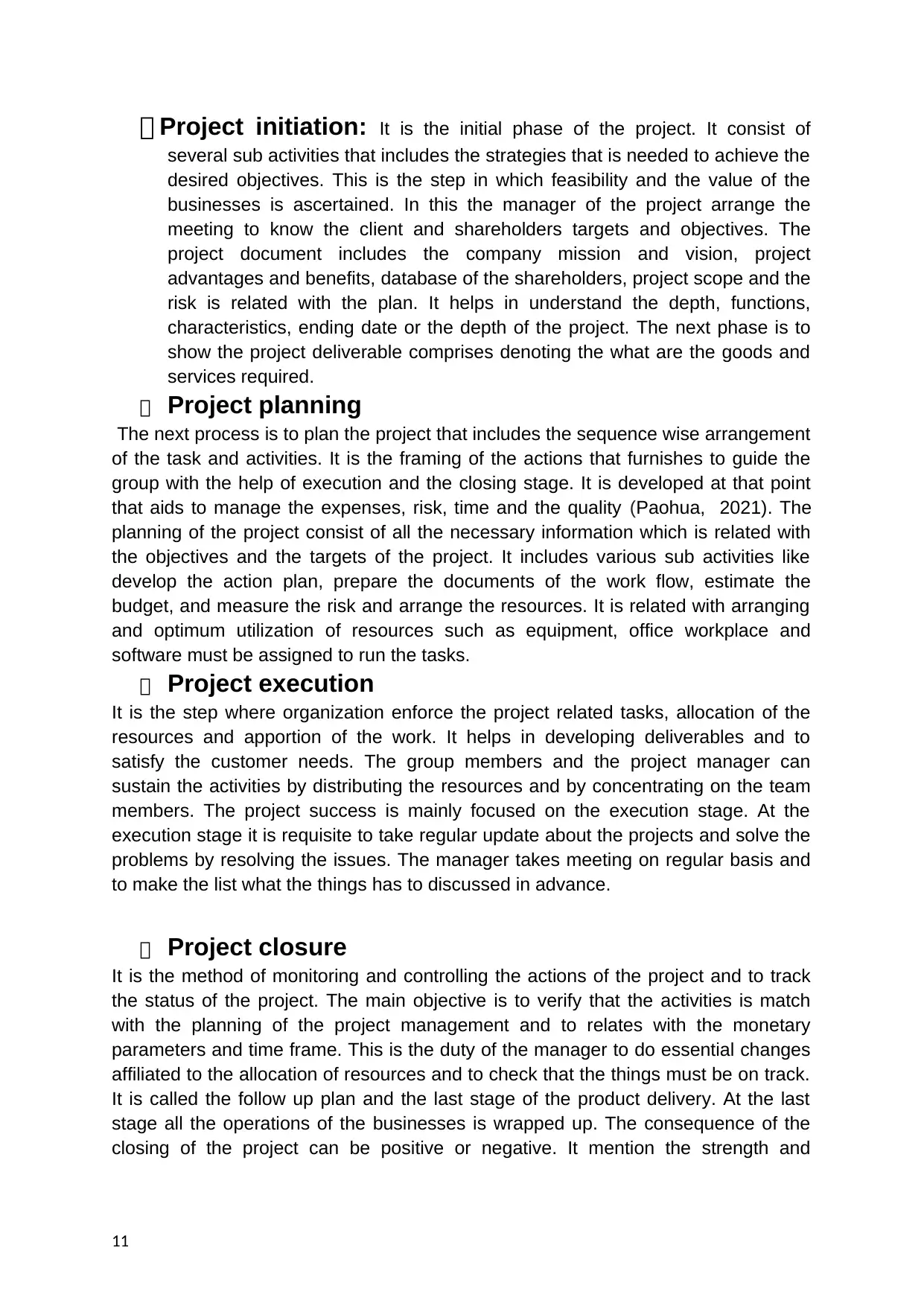
Project initiation: It is the initial phase of the project. It consist of
several sub activities that includes the strategies that is needed to achieve the
desired objectives. This is the step in which feasibility and the value of the
businesses is ascertained. In this the manager of the project arrange the
meeting to know the client and shareholders targets and objectives. The
project document includes the company mission and vision, project
advantages and benefits, database of the shareholders, project scope and the
risk is related with the plan. It helps in understand the depth, functions,
characteristics, ending date or the depth of the project. The next phase is to
show the project deliverable comprises denoting the what are the goods and
services required.
Project planning
The next process is to plan the project that includes the sequence wise arrangement
of the task and activities. It is the framing of the actions that furnishes to guide the
group with the help of execution and the closing stage. It is developed at that point
that aids to manage the expenses, risk, time and the quality (Paohua, 2021). The
planning of the project consist of all the necessary information which is related with
the objectives and the targets of the project. It includes various sub activities like
develop the action plan, prepare the documents of the work flow, estimate the
budget, and measure the risk and arrange the resources. It is related with arranging
and optimum utilization of resources such as equipment, office workplace and
software must be assigned to run the tasks.
Project execution
It is the step where organization enforce the project related tasks, allocation of the
resources and apportion of the work. It helps in developing deliverables and to
satisfy the customer needs. The group members and the project manager can
sustain the activities by distributing the resources and by concentrating on the team
members. The project success is mainly focused on the execution stage. At the
execution stage it is requisite to take regular update about the projects and solve the
problems by resolving the issues. The manager takes meeting on regular basis and
to make the list what the things has to discussed in advance.
Project closure
It is the method of monitoring and controlling the actions of the project and to track
the status of the project. The main objective is to verify that the activities is match
with the planning of the project management and to relates with the monetary
parameters and time frame. This is the duty of the manager to do essential changes
affiliated to the allocation of resources and to check that the things must be on track.
It is called the follow up plan and the last stage of the product delivery. At the last
stage all the operations of the businesses is wrapped up. The consequence of the
closing of the project can be positive or negative. It mention the strength and
11
several sub activities that includes the strategies that is needed to achieve the
desired objectives. This is the step in which feasibility and the value of the
businesses is ascertained. In this the manager of the project arrange the
meeting to know the client and shareholders targets and objectives. The
project document includes the company mission and vision, project
advantages and benefits, database of the shareholders, project scope and the
risk is related with the plan. It helps in understand the depth, functions,
characteristics, ending date or the depth of the project. The next phase is to
show the project deliverable comprises denoting the what are the goods and
services required.
Project planning
The next process is to plan the project that includes the sequence wise arrangement
of the task and activities. It is the framing of the actions that furnishes to guide the
group with the help of execution and the closing stage. It is developed at that point
that aids to manage the expenses, risk, time and the quality (Paohua, 2021). The
planning of the project consist of all the necessary information which is related with
the objectives and the targets of the project. It includes various sub activities like
develop the action plan, prepare the documents of the work flow, estimate the
budget, and measure the risk and arrange the resources. It is related with arranging
and optimum utilization of resources such as equipment, office workplace and
software must be assigned to run the tasks.
Project execution
It is the step where organization enforce the project related tasks, allocation of the
resources and apportion of the work. It helps in developing deliverables and to
satisfy the customer needs. The group members and the project manager can
sustain the activities by distributing the resources and by concentrating on the team
members. The project success is mainly focused on the execution stage. At the
execution stage it is requisite to take regular update about the projects and solve the
problems by resolving the issues. The manager takes meeting on regular basis and
to make the list what the things has to discussed in advance.
Project closure
It is the method of monitoring and controlling the actions of the project and to track
the status of the project. The main objective is to verify that the activities is match
with the planning of the project management and to relates with the monetary
parameters and time frame. This is the duty of the manager to do essential changes
affiliated to the allocation of resources and to check that the things must be on track.
It is called the follow up plan and the last stage of the product delivery. At the last
stage all the operations of the businesses is wrapped up. The consequence of the
closing of the project can be positive or negative. It mention the strength and
11
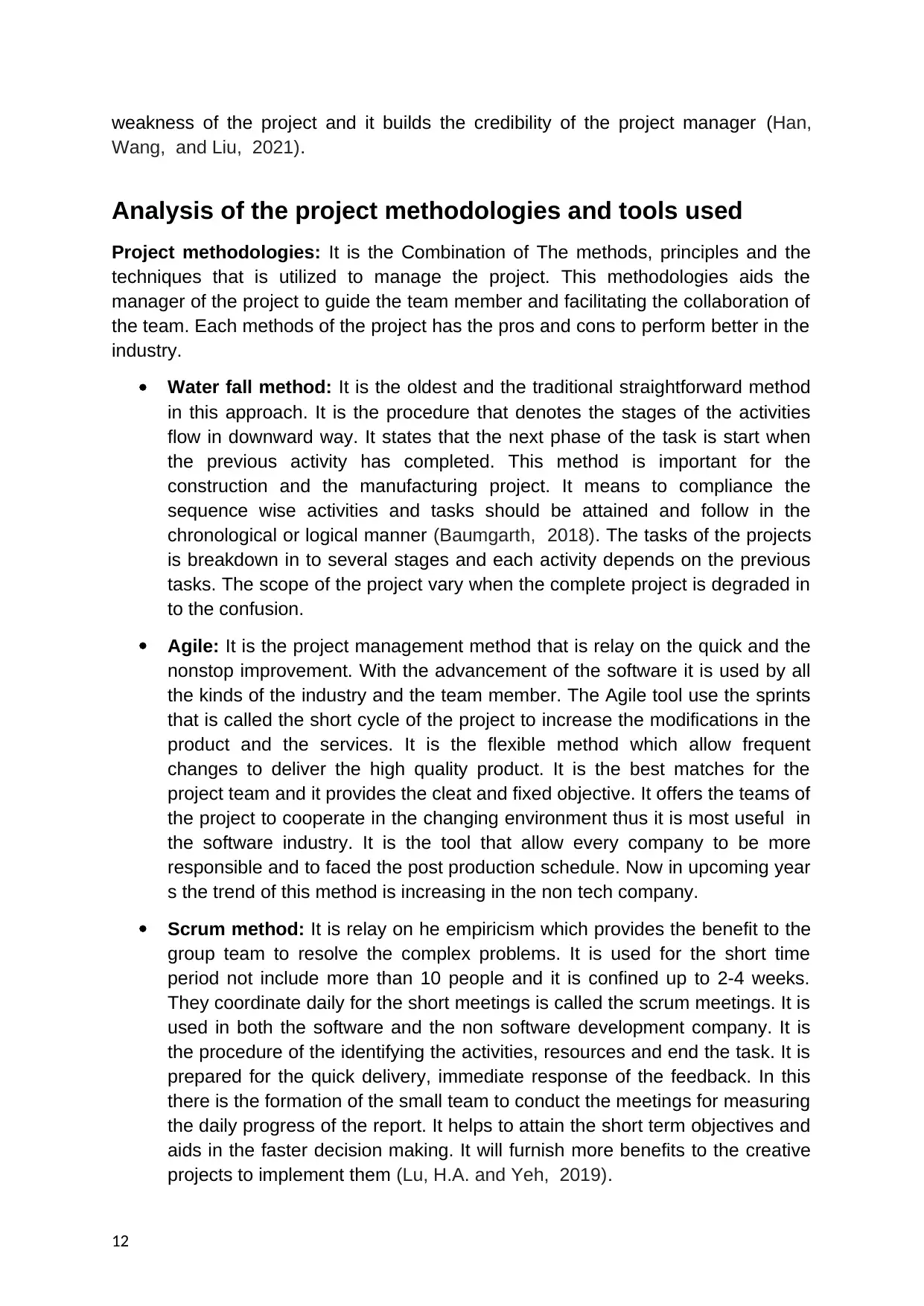
weakness of the project and it builds the credibility of the project manager (Han,
Wang, and Liu, 2021).
Analysis of the project methodologies and tools used
Project methodologies: It is the Combination of The methods, principles and the
techniques that is utilized to manage the project. This methodologies aids the
manager of the project to guide the team member and facilitating the collaboration of
the team. Each methods of the project has the pros and cons to perform better in the
industry.
Water fall method: It is the oldest and the traditional straightforward method
in this approach. It is the procedure that denotes the stages of the activities
flow in downward way. It states that the next phase of the task is start when
the previous activity has completed. This method is important for the
construction and the manufacturing project. It means to compliance the
sequence wise activities and tasks should be attained and follow in the
chronological or logical manner (Baumgarth, 2018). The tasks of the projects
is breakdown in to several stages and each activity depends on the previous
tasks. The scope of the project vary when the complete project is degraded in
to the confusion.
Agile: It is the project management method that is relay on the quick and the
nonstop improvement. With the advancement of the software it is used by all
the kinds of the industry and the team member. The Agile tool use the sprints
that is called the short cycle of the project to increase the modifications in the
product and the services. It is the flexible method which allow frequent
changes to deliver the high quality product. It is the best matches for the
project team and it provides the cleat and fixed objective. It offers the teams of
the project to cooperate in the changing environment thus it is most useful in
the software industry. It is the tool that allow every company to be more
responsible and to faced the post production schedule. Now in upcoming year
s the trend of this method is increasing in the non tech company.
Scrum method: It is relay on he empiricism which provides the benefit to the
group team to resolve the complex problems. It is used for the short time
period not include more than 10 people and it is confined up to 2-4 weeks.
They coordinate daily for the short meetings is called the scrum meetings. It is
used in both the software and the non software development company. It is
the procedure of the identifying the activities, resources and end the task. It is
prepared for the quick delivery, immediate response of the feedback. In this
there is the formation of the small team to conduct the meetings for measuring
the daily progress of the report. It helps to attain the short term objectives and
aids in the faster decision making. It will furnish more benefits to the creative
projects to implement them (Lu, H.A. and Yeh, 2019).
12
Wang, and Liu, 2021).
Analysis of the project methodologies and tools used
Project methodologies: It is the Combination of The methods, principles and the
techniques that is utilized to manage the project. This methodologies aids the
manager of the project to guide the team member and facilitating the collaboration of
the team. Each methods of the project has the pros and cons to perform better in the
industry.
Water fall method: It is the oldest and the traditional straightforward method
in this approach. It is the procedure that denotes the stages of the activities
flow in downward way. It states that the next phase of the task is start when
the previous activity has completed. This method is important for the
construction and the manufacturing project. It means to compliance the
sequence wise activities and tasks should be attained and follow in the
chronological or logical manner (Baumgarth, 2018). The tasks of the projects
is breakdown in to several stages and each activity depends on the previous
tasks. The scope of the project vary when the complete project is degraded in
to the confusion.
Agile: It is the project management method that is relay on the quick and the
nonstop improvement. With the advancement of the software it is used by all
the kinds of the industry and the team member. The Agile tool use the sprints
that is called the short cycle of the project to increase the modifications in the
product and the services. It is the flexible method which allow frequent
changes to deliver the high quality product. It is the best matches for the
project team and it provides the cleat and fixed objective. It offers the teams of
the project to cooperate in the changing environment thus it is most useful in
the software industry. It is the tool that allow every company to be more
responsible and to faced the post production schedule. Now in upcoming year
s the trend of this method is increasing in the non tech company.
Scrum method: It is relay on he empiricism which provides the benefit to the
group team to resolve the complex problems. It is used for the short time
period not include more than 10 people and it is confined up to 2-4 weeks.
They coordinate daily for the short meetings is called the scrum meetings. It is
used in both the software and the non software development company. It is
the procedure of the identifying the activities, resources and end the task. It is
prepared for the quick delivery, immediate response of the feedback. In this
there is the formation of the small team to conduct the meetings for measuring
the daily progress of the report. It helps to attain the short term objectives and
aids in the faster decision making. It will furnish more benefits to the creative
projects to implement them (Lu, H.A. and Yeh, 2019).
12
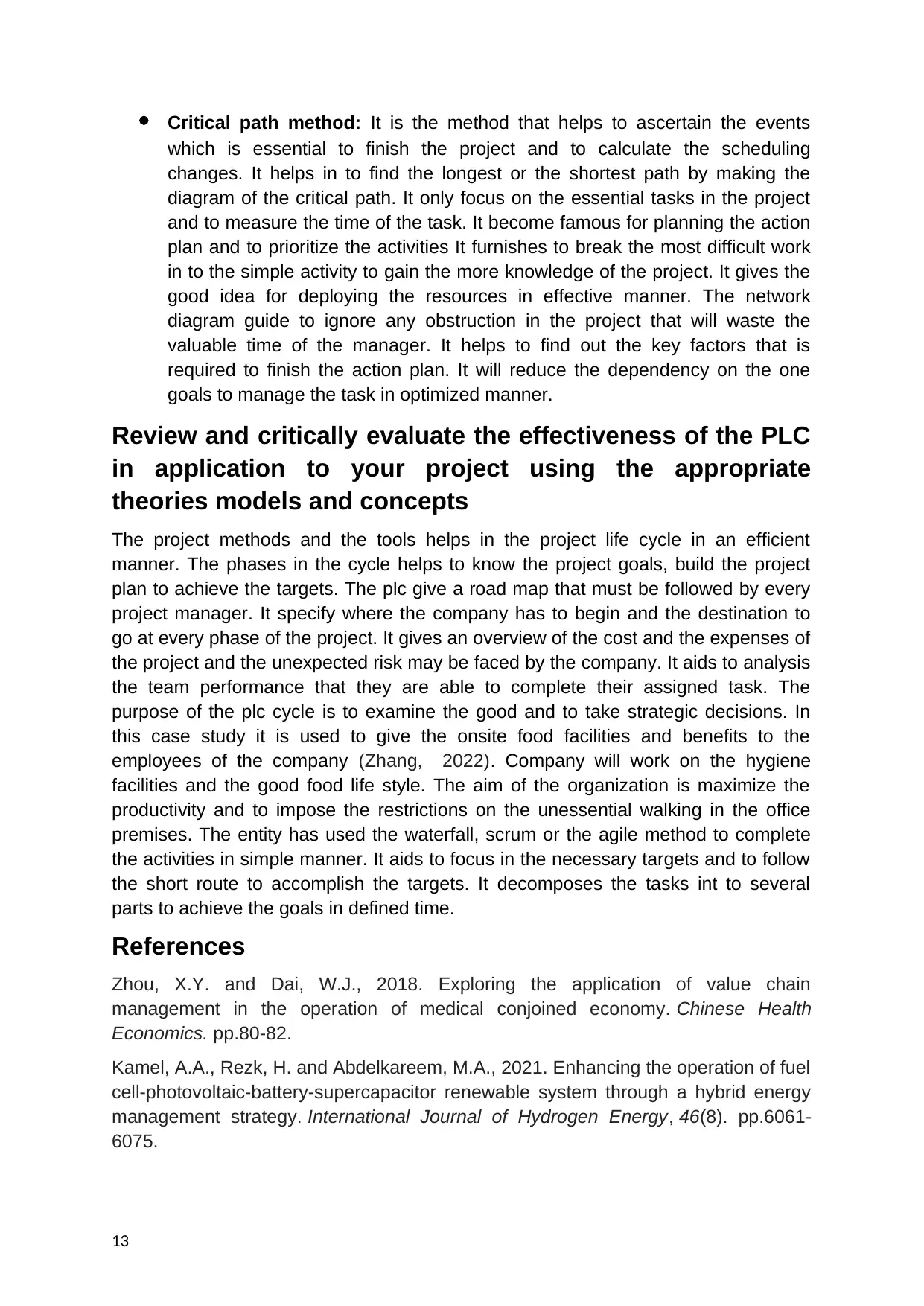
Critical path method: It is the method that helps to ascertain the events
which is essential to finish the project and to calculate the scheduling
changes. It helps in to find the longest or the shortest path by making the
diagram of the critical path. It only focus on the essential tasks in the project
and to measure the time of the task. It become famous for planning the action
plan and to prioritize the activities It furnishes to break the most difficult work
in to the simple activity to gain the more knowledge of the project. It gives the
good idea for deploying the resources in effective manner. The network
diagram guide to ignore any obstruction in the project that will waste the
valuable time of the manager. It helps to find out the key factors that is
required to finish the action plan. It will reduce the dependency on the one
goals to manage the task in optimized manner.
Review and critically evaluate the effectiveness of the PLC
in application to your project using the appropriate
theories models and concepts
The project methods and the tools helps in the project life cycle in an efficient
manner. The phases in the cycle helps to know the project goals, build the project
plan to achieve the targets. The plc give a road map that must be followed by every
project manager. It specify where the company has to begin and the destination to
go at every phase of the project. It gives an overview of the cost and the expenses of
the project and the unexpected risk may be faced by the company. It aids to analysis
the team performance that they are able to complete their assigned task. The
purpose of the plc cycle is to examine the good and to take strategic decisions. In
this case study it is used to give the onsite food facilities and benefits to the
employees of the company (Zhang, 2022). Company will work on the hygiene
facilities and the good food life style. The aim of the organization is maximize the
productivity and to impose the restrictions on the unessential walking in the office
premises. The entity has used the waterfall, scrum or the agile method to complete
the activities in simple manner. It aids to focus in the necessary targets and to follow
the short route to accomplish the targets. It decomposes the tasks int to several
parts to achieve the goals in defined time.
References
Zhou, X.Y. and Dai, W.J., 2018. Exploring the application of value chain
management in the operation of medical conjoined economy. Chinese Health
Economics. pp.80-82.
Kamel, A.A., Rezk, H. and Abdelkareem, M.A., 2021. Enhancing the operation of fuel
cell-photovoltaic-battery-supercapacitor renewable system through a hybrid energy
management strategy. International Journal of Hydrogen Energy, 46(8). pp.6061-
6075.
13
which is essential to finish the project and to calculate the scheduling
changes. It helps in to find the longest or the shortest path by making the
diagram of the critical path. It only focus on the essential tasks in the project
and to measure the time of the task. It become famous for planning the action
plan and to prioritize the activities It furnishes to break the most difficult work
in to the simple activity to gain the more knowledge of the project. It gives the
good idea for deploying the resources in effective manner. The network
diagram guide to ignore any obstruction in the project that will waste the
valuable time of the manager. It helps to find out the key factors that is
required to finish the action plan. It will reduce the dependency on the one
goals to manage the task in optimized manner.
Review and critically evaluate the effectiveness of the PLC
in application to your project using the appropriate
theories models and concepts
The project methods and the tools helps in the project life cycle in an efficient
manner. The phases in the cycle helps to know the project goals, build the project
plan to achieve the targets. The plc give a road map that must be followed by every
project manager. It specify where the company has to begin and the destination to
go at every phase of the project. It gives an overview of the cost and the expenses of
the project and the unexpected risk may be faced by the company. It aids to analysis
the team performance that they are able to complete their assigned task. The
purpose of the plc cycle is to examine the good and to take strategic decisions. In
this case study it is used to give the onsite food facilities and benefits to the
employees of the company (Zhang, 2022). Company will work on the hygiene
facilities and the good food life style. The aim of the organization is maximize the
productivity and to impose the restrictions on the unessential walking in the office
premises. The entity has used the waterfall, scrum or the agile method to complete
the activities in simple manner. It aids to focus in the necessary targets and to follow
the short route to accomplish the targets. It decomposes the tasks int to several
parts to achieve the goals in defined time.
References
Zhou, X.Y. and Dai, W.J., 2018. Exploring the application of value chain
management in the operation of medical conjoined economy. Chinese Health
Economics. pp.80-82.
Kamel, A.A., Rezk, H. and Abdelkareem, M.A., 2021. Enhancing the operation of fuel
cell-photovoltaic-battery-supercapacitor renewable system through a hybrid energy
management strategy. International Journal of Hydrogen Energy, 46(8). pp.6061-
6075.
13
Paraphrase This Document
Need a fresh take? Get an instant paraphrase of this document with our AI Paraphraser
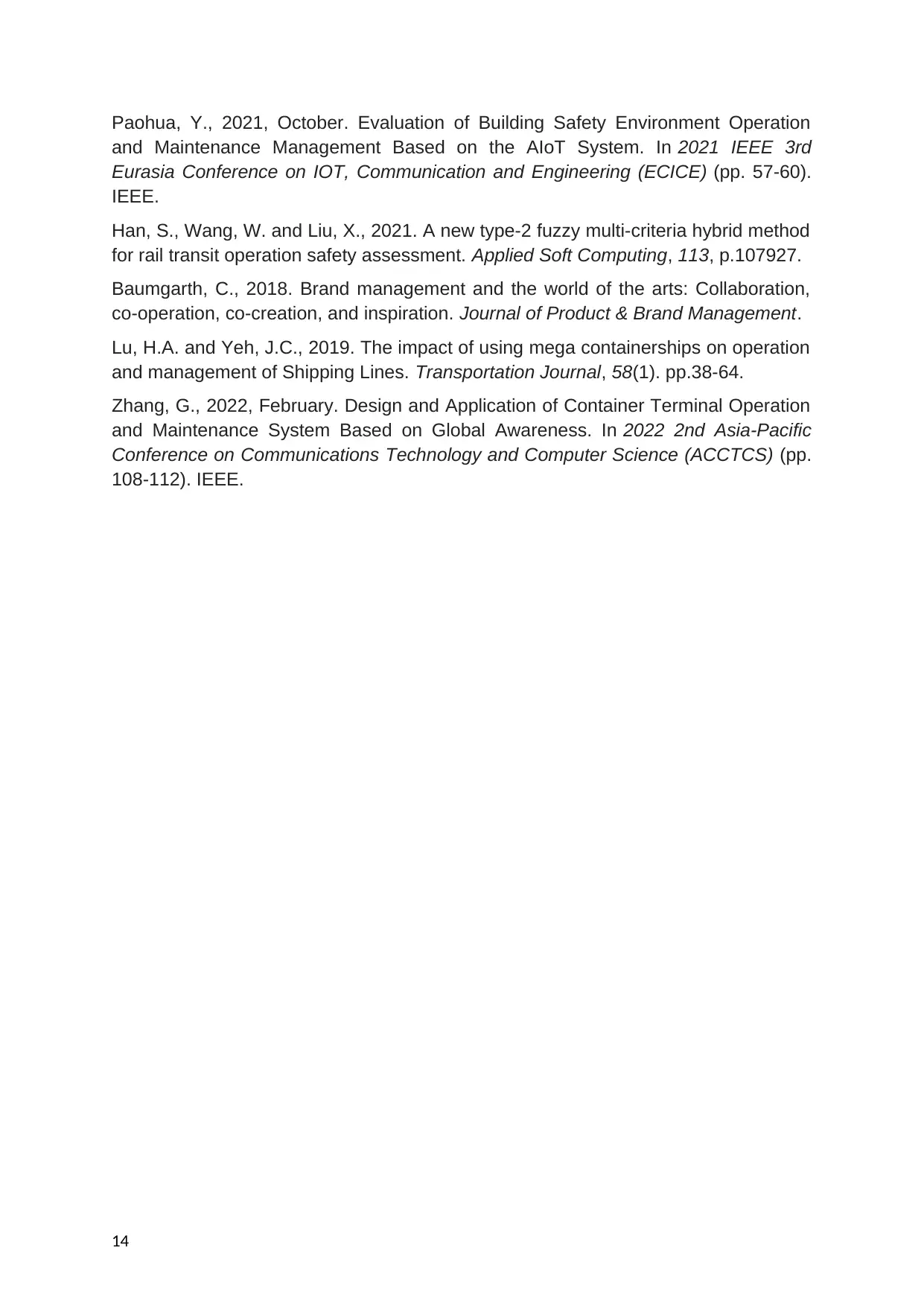
Paohua, Y., 2021, October. Evaluation of Building Safety Environment Operation
and Maintenance Management Based on the AIoT System. In 2021 IEEE 3rd
Eurasia Conference on IOT, Communication and Engineering (ECICE) (pp. 57-60).
IEEE.
Han, S., Wang, W. and Liu, X., 2021. A new type-2 fuzzy multi-criteria hybrid method
for rail transit operation safety assessment. Applied Soft Computing, 113, p.107927.
Baumgarth, C., 2018. Brand management and the world of the arts: Collaboration,
co-operation, co-creation, and inspiration. Journal of Product & Brand Management.
Lu, H.A. and Yeh, J.C., 2019. The impact of using mega containerships on operation
and management of Shipping Lines. Transportation Journal, 58(1). pp.38-64.
Zhang, G., 2022, February. Design and Application of Container Terminal Operation
and Maintenance System Based on Global Awareness. In 2022 2nd Asia-Pacific
Conference on Communications Technology and Computer Science (ACCTCS) (pp.
108-112). IEEE.
14
and Maintenance Management Based on the AIoT System. In 2021 IEEE 3rd
Eurasia Conference on IOT, Communication and Engineering (ECICE) (pp. 57-60).
IEEE.
Han, S., Wang, W. and Liu, X., 2021. A new type-2 fuzzy multi-criteria hybrid method
for rail transit operation safety assessment. Applied Soft Computing, 113, p.107927.
Baumgarth, C., 2018. Brand management and the world of the arts: Collaboration,
co-operation, co-creation, and inspiration. Journal of Product & Brand Management.
Lu, H.A. and Yeh, J.C., 2019. The impact of using mega containerships on operation
and management of Shipping Lines. Transportation Journal, 58(1). pp.38-64.
Zhang, G., 2022, February. Design and Application of Container Terminal Operation
and Maintenance System Based on Global Awareness. In 2022 2nd Asia-Pacific
Conference on Communications Technology and Computer Science (ACCTCS) (pp.
108-112). IEEE.
14
1 out of 14
Related Documents
Your All-in-One AI-Powered Toolkit for Academic Success.
+13062052269
info@desklib.com
Available 24*7 on WhatsApp / Email
![[object Object]](/_next/static/media/star-bottom.7253800d.svg)
Unlock your academic potential
© 2024 | Zucol Services PVT LTD | All rights reserved.
